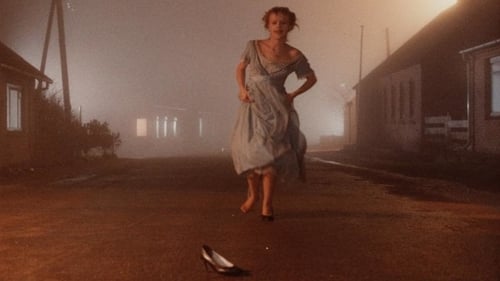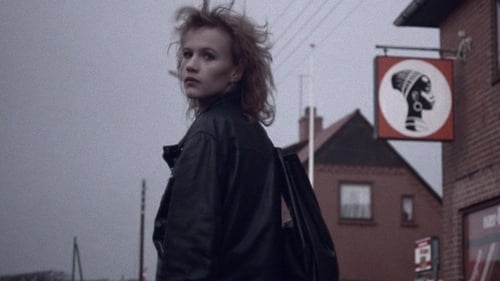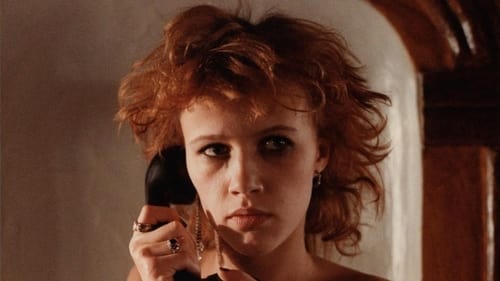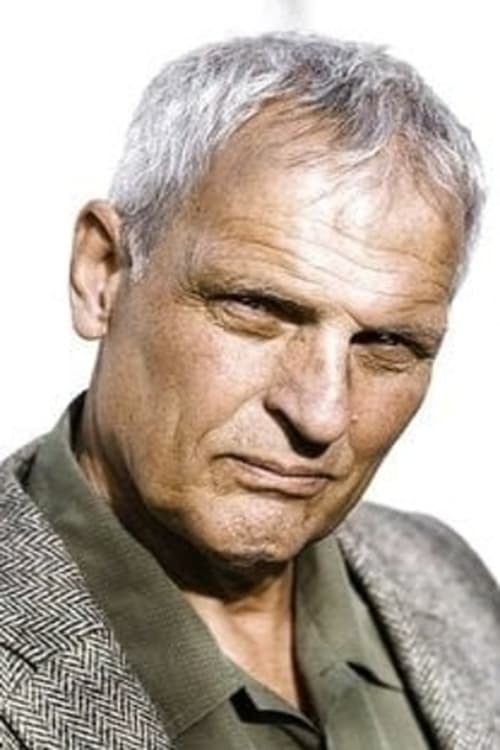
Producer
Where does the dream begin and reality end? In Dreaming Arizona, this is the question both for the central figures and for the viewer. Known for his staged documentaries, Danish director Jon Bang Carlsen has five American teenagers from a small town in Arizona reenact their own lives—past, present and future.

Writer
Where does the dream begin and reality end? In Dreaming Arizona, this is the question both for the central figures and for the viewer. Known for his staged documentaries, Danish director Jon Bang Carlsen has five American teenagers from a small town in Arizona reenact their own lives—past, present and future.

Director
Where does the dream begin and reality end? In Dreaming Arizona, this is the question both for the central figures and for the viewer. Known for his staged documentaries, Danish director Jon Bang Carlsen has five American teenagers from a small town in Arizona reenact their own lives—past, present and future.

Director
Since the 1970s, the travelling and extremely productive film poet Jon Bang Carlsen has created an extensive body of work with a creative and personal look at the world, with the staged documentary as his preferred form. When his beloved wife passes away, he reaches for filmmaking as a way to give his grief a form. ‘The Banality of Grief’ is a cinematic love letter to a loved one and to the places where they shared their lives for 35 years. South Africa, the USA, their shared home by the water. The boundaries between past and present end in an impressionistic and deeply personal film, where existential and artistic thoughts are countered by new impressions, which testify that life is the greatest of them all. Jon Bang Carlsen is a rare and precious figure in Danish cinema. An adventurer with an ever-recording camera, who directs his gaze outwards even when his thoughts are turned inwards.

Cinematography
To what extent does a director stay objective and anonymously hidden behind the camera? The Danish director Jon Bang Carlsen knows for sure that the choices he makes in his films aren’t accidental. Several excerpts from his own work show that events in his personal life have a major influence on his work. In fact, he appears to be using images that he recognizes in particular. It’s a revelation for this filmmaker, who used to think he could stay objective and invisible. Topics such as doubting his faith, his runaway father and impressions from a carefree childhood are recurring themes in his diverse oeuvre. Showing us individual scenes, Carlsen comments in voice-over on the images and muses about his life and work.

Producer
To what extent does a director stay objective and anonymously hidden behind the camera? The Danish director Jon Bang Carlsen knows for sure that the choices he makes in his films aren’t accidental. Several excerpts from his own work show that events in his personal life have a major influence on his work. In fact, he appears to be using images that he recognizes in particular. It’s a revelation for this filmmaker, who used to think he could stay objective and invisible. Topics such as doubting his faith, his runaway father and impressions from a carefree childhood are recurring themes in his diverse oeuvre. Showing us individual scenes, Carlsen comments in voice-over on the images and muses about his life and work.

Screenplay
To what extent does a director stay objective and anonymously hidden behind the camera? The Danish director Jon Bang Carlsen knows for sure that the choices he makes in his films aren’t accidental. Several excerpts from his own work show that events in his personal life have a major influence on his work. In fact, he appears to be using images that he recognizes in particular. It’s a revelation for this filmmaker, who used to think he could stay objective and invisible. Topics such as doubting his faith, his runaway father and impressions from a carefree childhood are recurring themes in his diverse oeuvre. Showing us individual scenes, Carlsen comments in voice-over on the images and muses about his life and work.

Director
To what extent does a director stay objective and anonymously hidden behind the camera? The Danish director Jon Bang Carlsen knows for sure that the choices he makes in his films aren’t accidental. Several excerpts from his own work show that events in his personal life have a major influence on his work. In fact, he appears to be using images that he recognizes in particular. It’s a revelation for this filmmaker, who used to think he could stay objective and invisible. Topics such as doubting his faith, his runaway father and impressions from a carefree childhood are recurring themes in his diverse oeuvre. Showing us individual scenes, Carlsen comments in voice-over on the images and muses about his life and work.

Narrator
To what extent does a director stay objective and anonymously hidden behind the camera? The Danish director Jon Bang Carlsen knows for sure that the choices he makes in his films aren’t accidental. Several excerpts from his own work show that events in his personal life have a major influence on his work. In fact, he appears to be using images that he recognizes in particular. It’s a revelation for this filmmaker, who used to think he could stay objective and invisible. Topics such as doubting his faith, his runaway father and impressions from a carefree childhood are recurring themes in his diverse oeuvre. Showing us individual scenes, Carlsen comments in voice-over on the images and muses about his life and work.

Himself
What are the consequences of a young person to be famous at an early age, being a public person? "Født til Filmen" is about the Danish actress Stine Bierlich's (1967 - 2007) life and career. Through interviews with herself, with her family - Ann Bierlich (mother), Asger Leth (brother), Jørgen Leth (stepfather), friends and people from the film industry it tells us about Stine's life from being a child actress to becoming a celebrated young star of the 80's. The film is a comment on today's worshipping of stars, and how fame has almost become a drug in itself. It’s as if here’s every answer to any doubt. But as Stine's story shows, reality can actually be the opposite.

Editor

Writer

Director

Director
Seven versions of Riga, the city on the Baltic Sea, and its features as seen by outstanding European film directors: Sergei Loznitsa (The Old Jewish Cemetery), Ivars Seleckis (On Ķīpsala), Audrius Stonys (Riga Boats), Jaak Kilmi (Littering Prohibited!), Jon Bang Karlsen (Cats in Riga), Rainer Komers (Daugava Delta), and Bettina Henkel (Theatre Street 6).

Director of Photography
In his new feature film Jon Bang Carlsen inserts the viewer into the affluent suburbs of Los Angeles, a world where families put on a brave face to mask the tension and turmoil at home. The kids are rebelling and the parents doesn’t know how to deal with them. With their parents consent, the children are abducted and bundled into a van which takes them to a reform school in the middle of the desert, in Utah. Blending fact with fiction, Carlsen shows us how parents sometimes achieve control by surrendering it and how fabrications can help us understand real life.

Writer
In his new feature film Jon Bang Carlsen inserts the viewer into the affluent suburbs of Los Angeles, a world where families put on a brave face to mask the tension and turmoil at home. The kids are rebelling and the parents doesn’t know how to deal with them. With their parents consent, the children are abducted and bundled into a van which takes them to a reform school in the middle of the desert, in Utah. Blending fact with fiction, Carlsen shows us how parents sometimes achieve control by surrendering it and how fabrications can help us understand real life.

Director
In his new feature film Jon Bang Carlsen inserts the viewer into the affluent suburbs of Los Angeles, a world where families put on a brave face to mask the tension and turmoil at home. The kids are rebelling and the parents doesn’t know how to deal with them. With their parents consent, the children are abducted and bundled into a van which takes them to a reform school in the middle of the desert, in Utah. Blending fact with fiction, Carlsen shows us how parents sometimes achieve control by surrendering it and how fabrications can help us understand real life.

Producer

Writer
Portrait of God is a documentary road movie about the manhunt for the most wanted person in the world. The film is constructed as a classic detective story. A middle-aged detective shadows the suspect through the highs and lows of South African society until he ends up in a gigantic prison in Cape Town bursting with murderers, thieves, and rapists.

Cinematography
Portrait of God is a documentary road movie about the manhunt for the most wanted person in the world. The film is constructed as a classic detective story. A middle-aged detective shadows the suspect through the highs and lows of South African society until he ends up in a gigantic prison in Cape Town bursting with murderers, thieves, and rapists.

Director
Portrait of God is a documentary road movie about the manhunt for the most wanted person in the world. The film is constructed as a classic detective story. A middle-aged detective shadows the suspect through the highs and lows of South African society until he ends up in a gigantic prison in Cape Town bursting with murderers, thieves, and rapists.

Self, Narrator
Portrait of God is a documentary road movie about the manhunt for the most wanted person in the world. The film is constructed as a classic detective story. A middle-aged detective shadows the suspect through the highs and lows of South African society until he ends up in a gigantic prison in Cape Town bursting with murderers, thieves, and rapists.

Writer
The film follows Hjalmar and Simon, the director’s sons, on a journey of discovery through a foreign land. The family has moved to South Africa, not long after the end of the rigid white apartheid regime, which brutally oppressed the country’s black population.

Director
The film follows Hjalmar and Simon, the director’s sons, on a journey of discovery through a foreign land. The family has moved to South Africa, not long after the end of the rigid white apartheid regime, which brutally oppressed the country’s black population.

Self, Narrator
I traveled to South Africa to find a white family living on a desolate farm. I wanted to film how they faced the new days of equality after the fall of Apartheid. But I soon lost my way both on the endless roads and in my way. Instead, the film became a story about two very different women who both experienced a tragic loss in the midst of a white community not too fond of the future.

Producer
I traveled to South Africa to find a white family living on a desolate farm. I wanted to film how they faced the new days of equality after the fall of Apartheid. But I soon lost my way both on the endless roads and in my way. Instead, the film became a story about two very different women who both experienced a tragic loss in the midst of a white community not too fond of the future.

Cinematography
I traveled to South Africa to find a white family living on a desolate farm. I wanted to film how they faced the new days of equality after the fall of Apartheid. But I soon lost my way both on the endless roads and in my way. Instead, the film became a story about two very different women who both experienced a tragic loss in the midst of a white community not too fond of the future.

Story
I traveled to South Africa to find a white family living on a desolate farm. I wanted to film how they faced the new days of equality after the fall of Apartheid. But I soon lost my way both on the endless roads and in my way. Instead, the film became a story about two very different women who both experienced a tragic loss in the midst of a white community not too fond of the future.

Director
I traveled to South Africa to find a white family living on a desolate farm. I wanted to film how they faced the new days of equality after the fall of Apartheid. But I soon lost my way both on the endless roads and in my way. Instead, the film became a story about two very different women who both experienced a tragic loss in the midst of a white community not too fond of the future.

Cinematography
Jon Bang Carlsen's essay about his way of approaching reality with a camera. Following the filming of "It's Now or Never", the story of an Irish bachelor's quest for love, Jon Bang Carlsen elaborates on how he manipulates reality in order to get to the core of it. " Staged documentary " he calls his method.

Producer
Jon Bang Carlsen's essay about his way of approaching reality with a camera. Following the filming of "It's Now or Never", the story of an Irish bachelor's quest for love, Jon Bang Carlsen elaborates on how he manipulates reality in order to get to the core of it. " Staged documentary " he calls his method.

Writer
Jon Bang Carlsen's essay about his way of approaching reality with a camera. Following the filming of "It's Now or Never", the story of an Irish bachelor's quest for love, Jon Bang Carlsen elaborates on how he manipulates reality in order to get to the core of it. " Staged documentary " he calls his method.

Director
Jon Bang Carlsen's essay about his way of approaching reality with a camera. Following the filming of "It's Now or Never", the story of an Irish bachelor's quest for love, Jon Bang Carlsen elaborates on how he manipulates reality in order to get to the core of it. " Staged documentary " he calls his method.

Narrator (voice)
Jon Bang Carlsen's essay about his way of approaching reality with a camera. Following the filming of "It's Now or Never", the story of an Irish bachelor's quest for love, Jon Bang Carlsen elaborates on how he manipulates reality in order to get to the core of it. " Staged documentary " he calls his method.

Producer
The irish west coast: Jimmy, a lonesome man in his mid-50s, dreams of having a wife. He contacts a matchmaker.

Writer
The irish west coast: Jimmy, a lonesome man in his mid-50s, dreams of having a wife. He contacts a matchmaker.

Director
The irish west coast: Jimmy, a lonesome man in his mid-50s, dreams of having a wife. He contacts a matchmaker.

Screenplay
Set in 1962 during the Berlin crisis, the contented lifestyle of Carmen and her kid brother, whom she's nicknamed Babyface, comes to an abrupt end when their parents acrimoniously separate.

Director
Set in 1962 during the Berlin crisis, the contented lifestyle of Carmen and her kid brother, whom she's nicknamed Babyface, comes to an abrupt end when their parents acrimoniously separate.

A group of school-mates form a resistance group in nazi-occupied Denmark.

Director
A young woman goes on a vacation at an old farm, which once belonged to her deceased grandmother. Childhood traumas and the memories of her strict and authoritarian grandmother haunts the young woman and leads her to scary delusions and a mental breakdown.

Writer
Drama about a young Dane who has traveled to America to find the father he can hardly remember. In New Mexico he gets to know the daughter of a political-religious fanatic who runs a "survival school". The young Dane is interested in the girl and admits to school. Later, however, there will be a violent showdown with the fanatic. But was this man, in fact, his father?

Director
Drama about a young Dane who has traveled to America to find the father he can hardly remember. In New Mexico he gets to know the daughter of a political-religious fanatic who runs a "survival school". The young Dane is interested in the girl and admits to school. Later, however, there will be a violent showdown with the fanatic. But was this man, in fact, his father?

Director
Two aging ladies are preparing for the new season in the hotel that they manage in the Danish island of Fanø. They share memories of old times, clean and inspect the rooms and play a few tricks on one another.

Writer
During a production of "Hamlet", the withdrawn lead actor and the girl playing Ophelia, who has just escaped a life of drugs and prostitution, spark an unlikely and low-key romance.

Director
During a production of "Hamlet", the withdrawn lead actor and the girl playing Ophelia, who has just escaped a life of drugs and prostitution, spark an unlikely and low-key romance.

Angry Policeman
Fisher, an ex-detective, decides to take one final case when a mysterious serial killer claims the lives of several young girls. Fisher, unable to find the culprit, turns to Osbourne, a writer who was once respected for his contributions to the field of criminology. Fisher begins to use Osbourne's technique, which involves empathizing with serial killers; however, as the detective becomes increasingly engrossed in this method, things take a disturbing turn.

Director
A staged documentary about an American ex-Vietnam soldier who teaches other Americans - men, women, children - to use weapons to defend themselves and obtain the possibility to say: "NO".

Writer
A documentary comedy about extras in Hollywood and how their dreams reflect the society they live in. The film's stage is an old hotel in the middle of Hollywood. Dilapidated inside as well as outside, but the passing of time hasn't eradicated all traces of an elegant past. Until the beginning of the 1960th the Stars from Broadway lived in Montecito Hotel on Franklin Avenue when they flew in from New York to film at the big studios. But the Stars have disappeared and those who dream about being Stars have moved into their hotel rooms, the extras, the hookers, the pimps, the restless dreamers stuck in a hotel with a dying elevator that slowly drives them crazy.

Director
A documentary comedy about extras in Hollywood and how their dreams reflect the society they live in. The film's stage is an old hotel in the middle of Hollywood. Dilapidated inside as well as outside, but the passing of time hasn't eradicated all traces of an elegant past. Until the beginning of the 1960th the Stars from Broadway lived in Montecito Hotel on Franklin Avenue when they flew in from New York to film at the big studios. But the Stars have disappeared and those who dream about being Stars have moved into their hotel rooms, the extras, the hookers, the pimps, the restless dreamers stuck in a hotel with a dying elevator that slowly drives them crazy.

Writer

Director

Erik, politiker
It has hardly been seen before that a 83-year-old actor has starred in a Danish film, but it is the case here, where Kai Holm says goodbye to a long life in film and theater service. He plays an old peasant who on his deathbed is waiting for his son (Jon Bang Carlsen). In a few days he relives the village life, he comes from, and which was marked by a hard and authoritarian upbringing. He is at his father's deathbed despair because it is still impossible to make contact, and in a crisis situation, he recognizes his father's brutality in itself. The film draws a bitter picture of human relationships where dreams while they die, degenerates into power relations.


Director
The 76 year old Jenny Jespersen lives in Bovbjerg byt the west coast of Jutland in Denmark. She has a sober approach to life and a strong Christian faith. "A human with faith is like a bird without wings", she says. Poeticly the film shows Jenny and her everyday life on a farm with her bachelor son and all their habits. But it is also a portrait of a beautiful and special region shaped by rough weather and strong beliefs.

Writer
In the lead-up to Christmas 1974, an army of about seventy Santa Clauses, male and female, paraded through the city of Copenhagen, singing carols, handing out sweets and hot chocolate, and asking everyone what they wanted for Christmas. After spending a few days cementing the good image of Santa Claus, their generosity became increasingly radical. Among other things, the Santas climbed a barbed wire fence surrounding the recently shutte red General Motors assembly plant with the purpose of giving jobs back to “their rightful owners.” The week-long performance reached its crescendo inside one of Copenhagen’s biggest department stores when the Santas started handing out presents to customers directly off the shelves. The performance exposed the radical implications of the myth of Santa Claus’ boundless generosity, demonstrating that true generosity is impossible within the narrow terms of capitalist society.

Director
In the lead-up to Christmas 1974, an army of about seventy Santa Clauses, male and female, paraded through the city of Copenhagen, singing carols, handing out sweets and hot chocolate, and asking everyone what they wanted for Christmas. After spending a few days cementing the good image of Santa Claus, their generosity became increasingly radical. Among other things, the Santas climbed a barbed wire fence surrounding the recently shutte red General Motors assembly plant with the purpose of giving jobs back to “their rightful owners.” The week-long performance reached its crescendo inside one of Copenhagen’s biggest department stores when the Santas started handing out presents to customers directly off the shelves. The performance exposed the radical implications of the myth of Santa Claus’ boundless generosity, demonstrating that true generosity is impossible within the narrow terms of capitalist society.







